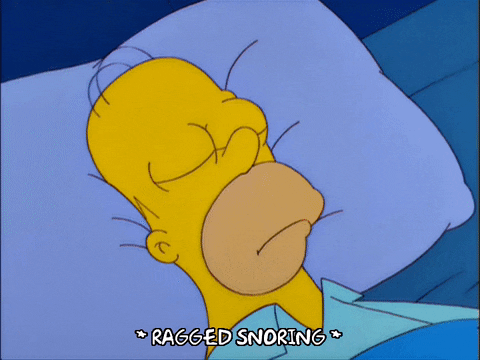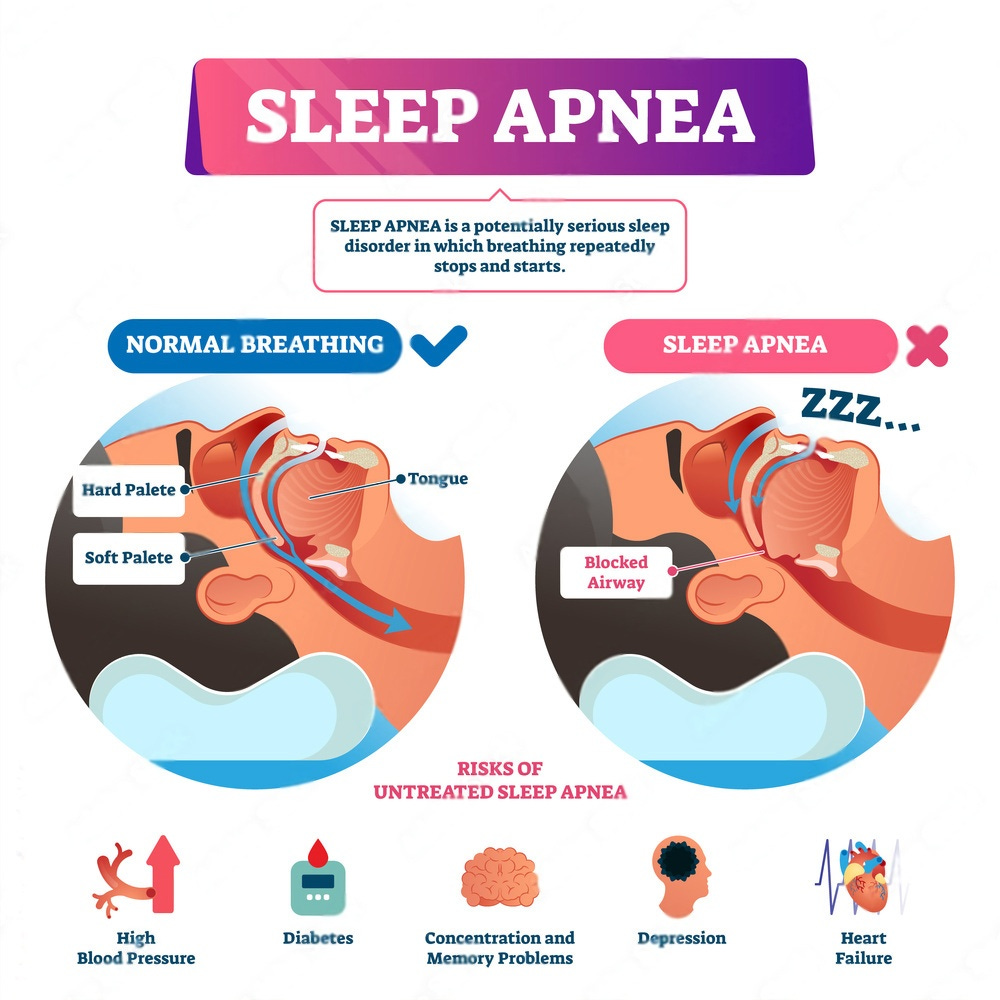Decoding Sleep Apnea Symptoms: Recognizing Early Indicators and Seeking Help
Explore the causes, symptoms, and effective treatments for sleep apnea. Learn how to manage and improve your quality of life

Sleep apnea is a common and potentially serious sleep disorder characterized by repeated interruptions in breathing during sleep. These pauses in breathing, known as apneas, can last for a few seconds to minutes and may occur multiple times throughout the night. Understanding the causes and symptoms of sleep apnea is crucial for early detection and effective management of this condition.
Join me as I explore the latest breakthroughs in health, in my quest to provide insights to promote a long healthy and pain-free life.
Causes of Sleep Apnea
Unveiling the Root Causes of Sleep Apnea. Brief overview and detailed exploration of the factors contributing to sleep apnea.
Obstructive Sleep Apnea (OSA): The most prevalent form of sleep apnea, OSA occurs when the muscles in the throat relax excessively during sleep, leading to a partial or complete blockage of the upper airway. This obstruction can be caused by factors such as excess weight, obesity, and the positioning of the tongue and tonsils. Factors that increase the risk of OSA include:
- Excess weight: Obesity greatly increases the risk of OSA due to fat deposits around the upper airway that can obstruct breathing.
- Neck circumference: A thicker neck may have a narrower airway, which can be more likely to collapse during sleep.
- A narrowed airway: Some people have a naturally narrow throat or enlarged tonsils or adenoids that can block the airway.
- Being male: Men are more likely to have sleep apnea than women.
- Age: The risk increases with age, although it seems to level off after the 60s.
- Family history: A family history of sleep apnea may increase the risk.
- Use of alcohol, sedatives, or tranquilizers: These substances can relax the muscles in your throat, which can worsen OSA.
- Smoking: Smokers are more likely to have OSA than non-smokers.
- Nasal congestion: If you have difficulty breathing through your nose due to an anatomical problem or allergies, you're more likely to develop OSA.
Central Sleep Apnea (CSA): Unlike OSA, CSA is less common and is associated with a failure of the brain to send proper signals to the muscles responsible for breathing. This disruption in communication can result in a temporary cessation of breathing. CSA is often linked to certain medical conditions, such as heart failure and disorders affecting the central nervous system. Causes of CSA can include:
- Heart failure
- Stroke
- Use of certain medications such as opioids
Complex/Mixed Sleep Apnea: Some individuals may experience a combination of obstructive and central sleep apnea, referred to as complex or mixed sleep apnea. This form of the disorder presents challenges in diagnosis and treatment, as it requires addressing both obstructive and central components.
Risk Factors: Several factors increase the risk of developing sleep apnea. These include obesity, excess weight around the neck, a narrow airway, being male, being older, family history of sleep apnea, and certain medical conditions such as hypertension.

Symptoms of Sleep Apnea
Recognizing Sleep Apnea: Common Signs and Symptoms. Comprehensive coverage of the varied symptoms associated with sleep apnea.
- Loud and Persistent Snoring: Snoring is one of the most common symptoms of sleep apnea, although not everyone who snores has the condition. The sound is created by the vibration of tissues in the throat as airflow becomes restricted.
- Episodes of Stopped Breathing During Sleep: Individuals with sleep apnea may experience episodes of stopped breathing, known as apneas. These interruptions in breathing can last for a few seconds to minutes and may occur multiple times throughout the night. Often, these episodes are reported by another person who notices the irregular breathing patterns.
- Gasping for Air During Sleep: Another sign of sleep apnea is gasping for air during sleep. This can occur as the body struggles to resume breathing after a pause in airflow.
- Awakening with a Dry Mouth: Breathing through the mouth during sleep, which is common in individuals with sleep apnea, can lead to waking up with a dry and parched mouth.
- Morning Headache: Individuals with sleep apnea may experience morning headaches. This symptom is possibly linked to changes in oxygen and carbon dioxide levels in the blood during episodes of interrupted breathing.
- Insomnia or Restless Sleep: Difficulty staying asleep is another symptom of sleep apnea. The disruptions in breathing can lead to restless sleep and frequent awakenings throughout the night.
- Excessive Daytime Sleepiness: One of the most significant consequences of sleep apnea is excessive daytime sleepiness. Despite spending a full night in bed, individuals may feel consistently tired during the day, impacting their overall energy levels and alertness.
- Difficulty Paying Attention While Awake: Sleep apnea can affect cognitive function, leading to difficulty paying attention and problems with concentration. This can have implications for daily activities such as work and learning.
- Irritability: Lack of quality sleep due to sleep apnea can contribute to mood changes, including irritability. Individuals may find themselves feeling more easily frustrated and short-tempered.
If sleep apnea is suspected, a healthcare professional may recommend a sleep study (polysomnography) to diagnose the severity and type of sleep apnea. Early diagnosis and appropriate treatment, which may include lifestyle changes, positive airway pressure therapy (e.g., CPAP), oral appliances, or surgery in certain cases, can significantly improve the quality of sleep and overall health for individuals with sleep apnea.
Diagnosis of Sleep Apnea
Navigating Sleep Apnea: Detailed insights into diagnosis methods.
Diagnosis:
The diagnosis of sleep apnea involves a comprehensive evaluation, with a key component being a sleep study, also known as polysomnography. This study is typically conducted in a sleep center, where various physiological parameters are monitored during the night. These parameters include brain activity, eye movement, heart rate, respiratory effort, airflow, and blood oxygen levels. The data collected during the sleep study helps in assessing the frequency and severity of apneas and hypopneas (partial blockages of the airway) and determining the type of sleep apnea.
Additionally, home sleep apnea testing (HSAT) is sometimes used in specific cases, providing a more convenient and cost-effective option for monitoring sleep patterns. However, it is generally reserved for individuals with a high pre-test probability of moderate to severe obstructive sleep apnea. The severity of sleep apnea is usually classified based on the apnea-hypopnea index (AHI), which quantifies the number of apneas and hypopneas per hour of sleep.
Importance of Timely Diagnosis and Treatment:
Recognizing the symptoms and risk factors of sleep apnea is crucial for timely diagnosis and treatment. Left untreated, sleep apnea can lead to serious health complications, including cardiovascular problems, hypertension, and an increased risk of accidents due to daytime fatigue. Furthermore, the chronic sleep disruption associated with sleep apnea may contribute to a decline in cognitive function and overall quality of life.
By seeking professional medical advice, undergoing appropriate diagnostic testing, and adhering to a prescribed treatment plan, individuals with sleep apnea can significantly improve their sleep quality, reduce associated health risks, and enhance their overall well-being. Early intervention is key to minimizing the impact of sleep apnea and promoting long-term health and vitality.

Consequences of Untreated Sleep Apnea
The Silent Threat: Health Consequences of Ignoring Sleep Apnea. Highlighting the potential risks and long-term health effects of leaving sleep apnea untreated.
Leaving sleep apnea untreated can have profound and far-reaching consequences, posing significant dangers and health risks that extend beyond the realm of sleep disturbances. The condition, characterized by repeated interruptions in breathing during sleep, has been linked to a range of adverse outcomes, emphasizing the importance of timely diagnosis and intervention.
One of the primary concerns is the impact on cardiovascular health. Untreated sleep apnea is associated with an increased risk of high blood pressure, heart disease, and stroke. The frequent disruptions in oxygen supply to the body during apnea episodes can place considerable strain on the cardiovascular system, contributing to the development and exacerbation of these conditions. Over time, this heightened cardiovascular risk can lead to serious, potentially life-threatening complications.
In addition to cardiovascular issues, untreated sleep apnea can result in daytime fatigue and excessive sleepiness, increasing the likelihood of accidents and impaired cognitive function. The persistent lack of quality sleep interferes with the body's natural restorative processes, impairing memory, concentration, and overall cognitive performance. This can impact daily activities, work performance, and quality of life.
Furthermore, untreated sleep apnea has been associated with metabolic disturbances, including insulin resistance and an increased risk of developing type 2 diabetes. The hormonal imbalances caused by disrupted sleep patterns can lead to weight gain, exacerbating the severity of sleep apnea and creating a detrimental cycle of health issues.
Untreated sleep apnea may also contribute to mood disorders such as depression and anxiety. The chronic sleep disruptions and physiological stress caused by apnea episodes can negatively impact mental health, affecting emotional well-being and the ability to cope with stressors.
Effective Sleep Apnea Treatments
Breaking Free: Effective Treatments to Manage Sleep Apnea. In-depth exploration of conventional and alternative treatments for sleep apnea.
Treating sleep apnea involves a multifaceted approach, considering the severity of the condition and individual patient characteristics. From lifestyle modifications to medical interventions, here's a comprehensive overview of effective treatments for sleep apnea:
- Lifestyle Changes:
- Weight Management: Losing excess weight can significantly reduce the severity of obstructive sleep apnea (OSA). Even a modest weight loss can lead to improvements.
- Positional Therapy: Encouraging individuals to sleep in positions that minimize airway obstruction, especially for those with positional OSA.
- Positive Airway Pressure (PAP) Therapy:
- Continuous Positive Airway Pressure (CPAP): The most common and effective treatment for moderate to severe OSA. A CPAP machine delivers a continuous stream of air through a mask, preventing airway collapse during sleep.
- level Positive Airway Pressure (BiPAP): Similar to CPAP but with variable air pressure levels for inhalation and exhalation, suitable for individuals who have difficulty tolerating constant pressure.
- Oral Appliances:
- Custom-made devices, often recommended by dentists, reposition the jaw and tongue to keep the airway open. Particularly useful for mild to moderate OSA or for individuals who cannot tolerate CPAP.
- Surgery:
- Uvulopalatopharyngoplasty (UPPP): Removes excess tissue from the throat.
- Genioglossus Advancement (GA) and Maxillomandibular Advancement (MMA): Repositioning the tongue or jaw to enlarge the airway.
- Inspire Therapy: An implantable device that stimulates the hypoglossal nerve to prevent airway collapse during sleep.
- Adaptive Servo-Ventilation (ASV):
- A specialized positive airway pressure device that adjusts pressure based on the patient's breathing patterns. Often used for treating central sleep apnea.
- Nasal EPAP (Expiratory Positive Airway Pressure):
- Disposable devices applied over the nostrils to create positive pressure during exhalation, preventing airway collapse.
- Hypoglossal Nerve Stimulation:
- Involves an implanted device that monitors breathing patterns and stimulates the hypoglossal nerve to keep the airway open.
- Sleep Position Therapy Devices:
- Wearable devices that provide feedback or gentle vibrations to discourage sleeping in positions that contribute to airway obstruction.
The choice of treatment depends on the type and severity of sleep apnea, patient preference, and individual health factors. Lifestyle changes often complement other treatments, enhancing overall effectiveness.
Managing Sleep Apnea Without CPAP
Beyond the Machine: Practical Tips for Managing Sleep Apnea Naturally. Insightful strategies and lifestyle changes to manage sleep apnea without relying on CPAP.
Managing sleep apnea without relying on Continuous Positive Airway Pressure (CPAP) machines is possible through a combination of lifestyle changes and alternative interventions. Here are practical tips and strategies for effectively managing sleep apnea:
Weight Management:
Engage in a weight loss program if overweight. Shedding excess pounds can reduce the severity of obstructive sleep apnea (OSA). Even a modest weight loss can lead to improvements in symptoms.
Positional Therapy:
Identify and maintain a sleep position that minimizes airway obstruction. Some individuals experience sleep apnea primarily when sleeping on their backs. Using positional aids or sleeping on one's side may help reduce apnea episodes.
Lifestyle Modifications:
Avoid alcohol and sedatives, especially before bedtime, as they can relax the muscles in the throat, contributing to airway collapse. Limiting caffeine intake and avoiding heavy meals close to bedtime can also be beneficial.
Oral Appliances:
Consider using oral appliances prescribed by dentists. These custom-made devices reposition the jaw and tongue, preventing airway obstruction. Oral appliances are particularly useful for individuals with mild to moderate OSA or those who cannot tolerate CPAP.
Treatment of Nasal Congestion:
Address nasal congestion or allergies, as these can contribute to airway blockage. Using saline nasal sprays, decongestants, or allergy medications may improve nasal airflow.
Sleep Position Therapy Devices:
Utilize wearable devices that provide feedback or gentle vibrations to discourage sleeping in positions that contribute to airway obstruction. These devices can help train individuals to maintain positions that minimize apnea episodes.
Regular Exercise:
Engage in regular physical activity. Exercise can contribute to weight loss, improve muscle tone, and enhance overall cardiovascular health, reducing the severity of sleep apnea.
Quit Smoking:
If applicable, quit smoking. Smoking can increase inflammation and fluid retention in the airway, exacerbating sleep apnea symptoms.
Elevate the Head of the Bed:
Use pillows or a bed wedge to elevate the head of the bed. This can help prevent the tongue and soft palate from collapsing backward, reducing the likelihood of airway obstruction.
Stay Consistent with Sleep Patterns:
Establish and maintain a regular sleep schedule. Consistency in sleep patterns helps regulate the body's internal clock and may contribute to improved sleep quality.
Long-Term Outlook: Living a Healthy Life with Sleep Apnea
Thriving with Sleep Apnea: Long-Term Wellness Strategies. Addressing ways to lead a fulfilling life while effectively managing sleep apnea.
Living a long and healthy life with sleep apnea is indeed possible with appropriate management and lifestyle choices. While sleep apnea can present challenges, adopting a proactive approach can significantly improve the long-term outlook. Here are strategies for maintaining overall health and well-being despite having sleep apnea:
Treatment Adherence:
Commit to the prescribed treatment plan. Whether using CPAP, oral appliances, or other interventions, consistent adherence is crucial for managing sleep apnea effectively.
Regular Follow-Ups:
Schedule regular follow-up appointments with healthcare providers to monitor the effectiveness of the chosen treatment and make adjustments as needed. Regular check-ups ensure that any emerging issues are addressed promptly.
Healthy Lifestyle Choices:
Adopt a healthy lifestyle. Focus on maintaining a balanced diet, engaging in regular physical activity, and managing stress. These lifestyle choices contribute to overall well-being and can positively impact sleep quality.
Weight Management:
If applicable, strive to achieve and maintain a healthy weight. Weight loss, even modest, can reduce the severity of sleep apnea and improve symptoms.
Positional Therapy:
Explore positional therapy, which involves finding and maintaining sleep positions that minimize airway obstruction. For some individuals, this can be a practical and effective approach.
Quit Smoking:
If applicable, quit smoking. Smoking can exacerbate the symptoms of sleep apnea and increase the risk of cardiovascular issues.
Alcohol and Sedative Avoidance:
Avoid alcohol and sedatives, especially before bedtime. These substances can relax the muscles in the throat, contributing to airway collapse.
Regular Exercise:
Engage in regular physical activity. Exercise not only supports weight management but also enhances cardiovascular health and overall fitness, positively influencing sleep apnea.
Addressing Nasal Congestion:
Treat nasal congestion or allergies promptly, as these conditions can contribute to airway blockage. Using nasal sprays or allergy medications can improve nasal airflow.
Quality Sleep Environment:
Create a conducive sleep environment. Ensure the bedroom is comfortable, quiet, and dark. Using supportive pillows or adjusting the bed's elevation can aid in maintaining open airways during sleep.
- Seek Emotional Support:
Reach out for emotional support. Living with a chronic condition like sleep apnea may come with challenges. Seeking support from loved ones or joining support groups can provide encouragement and shared experiences.
By incorporating these strategies into daily life, individuals with sleep apnea can not only manage the condition effectively but also enhance their overall health and longevity.

Gender Disparities in Sleep Apnea: Unraveling Symptomatic Differences
Men vs. Women: Understanding Unique Aspects of Sleep Apnea. Exploring any gender-based differences in symptoms and experiences of sleep apnea.
Women with obstructive sleep apnea (OSA) may indeed experience symptoms differently than men, and this can affect the recognition and diagnosis of the condition. Women are more likely to report symptoms such as trouble sleeping, morning headaches, and feelings of depression. They may also experience partial blockages or periods of labored breathing rather than complete airway blockages, which can disrupt sleep and cause daytime symptoms. Additionally, women with OSA are less likely to have breathing problems that are caused by a complete airway blockage.
The association between sleep apnea and depressive symptoms has been explored in various studies. While the relationship remains somewhat controversial, there is evidence to suggest that sleep apnea can increase the likelihood of depressive symptoms. This is particularly notable in certain subgroups, such as pregnant women and individuals with both sleep apnea and coronary heart disease (CHD). Furthermore, research has shown that the frequency of anxiety and depressive symptoms is higher in patients with OSA than in the general population, and this is regardless of gender.
Symptoms:
1. Snoring:
- Men: Loud and persistent snoring is often a common symptom.
- Women: Women with sleep apnea may snore less loudly or less frequently than men.
- Breathing Pauses:
- Men: Noticeable pauses in breathing during sleep.
- Women: Pauses may be less pronounced, and symptoms may manifest as subtle awakenings or gasping.
3. Insomnia:
- Women: Insomnia or difficulty staying asleep may be more common among women with sleep apnea.
4. Daytime Sleepiness:
- Men: More likely to experience pronounced daytime sleepiness.
- Women: May report fatigue and sleepiness but without the same intensity as men.
5. Depression and Anxiety:
- Women: More likely to experience symptoms of depression and anxiety related to sleep apnea.
Treatment:
CPAP Therapy:
Men and Women: CPAP therapy is a common and effective treatment for both genders. However, adherence to treatment may vary, and women may sometimes report finding it less comfortable.
- Oral Appliances:
Men and Women: Oral appliances that reposition the jaw and tongue can be effective, especially for mild to moderate sleep apnea. Women may find these devices more acceptable than CPAP. - Surgery:
Men and Women: Surgical interventions, such as uvulopalatopharyngoplasty (UPPP) or genioglossus advancement (GA), may be considered in specific cases where anatomical issues contribute to airway obstruction. - Weight Management:
Men and Women: Weight loss is often recommended, especially if excess weight contributes to the severity of sleep apnea. - Hormonal Influences:
Women: Hormonal factors, such as menopause and hormonal fluctuations during the menstrual cycle, can influence the severity of sleep apnea. This may impact treatment decisions. - Adherence to Treatment:
Adherence to treatment plans may vary between men and women. Factors such as comfort with devices, psychological aspects, and overall health may influence how well individuals comply with prescribed treatments.
In summary, women with sleep apnea are more likely to experience symptoms of depression and anxiety related to the condition, and these symptoms can sometimes lead to misdiagnosis or underdiagnosis of OSA in women. Recognizing these differences is crucial for proper diagnosis and management of sleep apnea in women.
Top 10 Frequently Asked Questions and Answers
Clarifying Doubts: Your Sleep Apnea Questions Answered. A concise Q&A section addressing common queries related to sleep apnea.
Can you fix sleep apnea?
Yes, various treatments, including lifestyle changes, CPAP therapy, and surgery, can effectively manage sleep apnea.
What happens if you leave sleep apnea untreated?
Untreated sleep apnea can lead to serious health issues, including cardiovascular problems, hypertension, and an increased risk of accidents due to daytime fatigue.
What causes sleep apnea to get worse?
Factors such as obesity, untreated underlying medical conditions, and lifestyle choices (e.g., smoking, alcohol) can contribute to the worsening of sleep apnea.
How do you fight sleep apnea?
Treatment options include lifestyle changes, CPAP therapy, oral appliances, and sometimes surgery, depending on the severity and type of sleep apnea.
Can I live a long life with sleep apnea?
With proper diagnosis and treatment, individuals with sleep apnea can lead long and healthy lives. Treatment adherence is key.
How do I get rid of sleep apnea without CPAP?
Lifestyle changes, weight management, positional therapy, and oral appliances are alternative options for managing sleep apnea without CPAP.
Can sleep apnea kill you?
While sleep apnea itself may not directly cause death, untreated sleep apnea can contribute to serious health conditions that may lead to premature death.
How does a CPAP (Continuous Positive Airway Pressure) machine treat sleep apnea?
Learn about the common use of CPAP machines and how they deliver a continuous stream of air to keep the airway open.
What factors contribute to sleep apnea?
Explore the various causes of sleep apnea, including obesity, anatomical factors, aging, family history, and specific medical conditions.
How is sleep apnea diagnosed?
Discover the diagnostic methods for sleep apnea, including polysomnography and home sleep apnea testing (HSAT).
Key Takeaways
- Sleep apnea is a serious sleep disorder characterized by repeated pauses in breathing during sleep. It can lead to poor sleep quality and increased health risks if left untreated.
- The most common symptoms include loud snoring, episodes of stopped breathing, gasping for air, morning headaches, insomnia, excessive daytime sleepiness, difficulty concentrating, and irritability.
- Main causes are obesity, anatomical factors, family history, gender (more common in men), and certain medical conditions.
- Diagnosis involves a sleep study (polysomnography) to monitor brain waves, oxygen levels, heart rate, breathing patterns and assess severity.
- Effective treatments include lifestyle changes, CPAP therapy, oral appliances fitted by a dentist, and sometimes surgery for severe cases.
- If untreated, sleep apnea significantly increases the risk of high blood pressure, heart disease, stroke, accidents due to fatigue, impaired cognitive function, and reduced quality of life.
- With proper diagnosis and adherence to tailored treatment, individuals with sleep apnea can live healthy, active, and fulfilling lives.
- Women may experience symptoms like depression, anxiety, fatigue, and insomnia more commonly than loud snoring and pronounced apneas.
- Lifestyle modifications like weight loss, avoiding alcohol, positional therapy, and oral appliances can help manage mild sleep apnea without CPAP.
- Regular follow-up with health professionals is crucial to monitor progress, adjust treatment plans, and optimize long-term health for individuals with sleep apnea.
Ready for better sleep? Connect with a Sleep Apnea professional such as Pulmonologist, Neurologist, Otolaryngologist or Sleep Medicine Specialist to discuss personalized strategies. Reach out today! 💤👩⚕️
Thank you for reading this post! If you found it helpful or informative, please consider sharing a 7 day free trial with your friends, family, or colleagues who might benefit from it.
Your support helps me reach more people and spread awareness on important topics like this. Together, we can make a difference!




